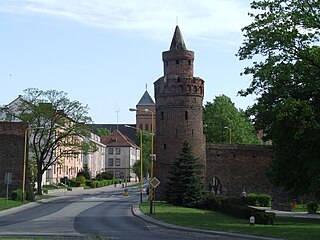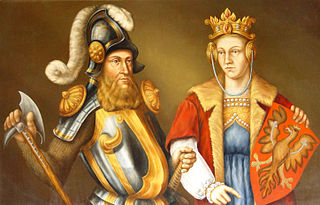
Koszalin is a city in northwestern Poland, in Western Pomerania. It is located 12 kilometres south of the Baltic Sea coast, and intersected by the river Dzierżęcinka. Koszalin is also a county-status city and capital of Koszalin County of West Pomeranian Voivodeship.

Pomerelia, also known as Eastern Pomerania, Vistula Pomerania, and also before World War II as Polish Pomerania, is a historical sub-region of Pomerania on the southern shore of the Baltic Sea in northern Poland.

Pyrzyce is a town in Pomerania, north-western Poland. As of 2007, it had 13,331 inhabitants. It is the capital of the Pyrzyce County in West Pomeranian Voivodeship.

Białogard is a historic town in Middle Pomerania, northwestern Poland, with 23,614 inhabitants as of December 2021. The capital of Białogard County in the West Pomeranian Voivodeship. It is the most important railroad junction of Middle Pomerania, which links Kołobrzeg with Piła and Gdańsk with Stargard.

Sławno is a town on the Wieprza river in Middle Pomerania region, north-western Poland, with 12,511 inhabitants (2019). It is the administrative seat of Gmina Sławno, though not part of it. The town is also the capital of Sławno County in West Pomeranian Voivodeship.

The Duchy of Pomerania was a duchy in Pomerania on the southern coast of the Baltic Sea, ruled by dukes of the House of Pomerania (Griffins). The country existed in the Middle Ages between years 1121–1160, 1264–1295, 1478–1531, and 1625–1637.

The History of Szczecin dates back to the 8th century. Throughout its history the city has been part of Poland, Denmark, Sweden and Germany. Since the Middle Ages, it is one of the largest and oldest cities in the historic region of Pomerania, and today, is it the largest city in northwestern Poland.

The history of Pomerania starts shortly before 1000 AD, with ongoing conquests by newly arrived Polan rulers. Before that, the area was recorded nearly 2000 years ago as Germania, and in modern times Pomerania has been split between Germany and Poland. Its name comes from the Old Polish po more, which means "(land) at the sea".

Farther Pomerania, Hinder Pomerania, Rear Pomerania or Eastern Pomerania, is a subregion of the historic region of Pomerania in north-western Poland, mostly within the West Pomeranian Voivodeship, while its easternmost parts are within the Pomeranian Voivodeship.

Bogislaw V, sometimes known as the Great, was a Duke of Pomerania.

Eric II or Erich II was a member of the House of Pomerania and was the ruling Duke of Pomerania-Wolgast from 1457 to 1474. He was the son of Wartislaw IX of Pomerania-Wolgast and Sophia, daughter of Eric IV of Saxe-Lauenburg.

Pomerania during the High Middle Ages covers the history of Pomerania in the 12th and 13th centuries.

Pomerania during the Late Middle Ages covers the history of Pomerania in the 14th and 15th centuries.

The Duchy of Pomerania-Stolp, also known as the Duchy of Stolp, and the Duchy of Słupsk, was a feudal duchy in Farther Pomerania. Its capital was Słupsk. It was ruled by the Griffin dynasty. It existed in the High Middle Ages era from 1368 to 1478.
The Treaty of Soldin was signed on 21 January 1466 at Soldin by the Brandenburgian elector Frederick II and the Pomeranian dukes Eric II and Wartislaw X. It was mediated by the town of Stettin. The treaty temporarily settled a conflict about the succession of Otto III, Duke of Pomerania, who had died without issue: Emperor Frederick III, elector Frederick II as well as Eric II and Wartislaw X of Pomerania claimed to be the rightful heir of Otto's share of the Duchy of Pomerania.

Wartislaw V. was a duke of Pomerania from the House of Griffin. He initially ruled Pomerania-Wolgast jointly with his elder brothers Barnim IV and Bogislaw V. He stood in their shadow and after 1368, he ruled his own part of the Duchy: the Land of Neustettin. Neustettin is now called Szczecinek.

Historical Western Pomerania, also called Cispomerania,Fore Pomerania, Front Pomerania or Hither Pomerania, is the western extremity of the historic region of Pomerania forming the southern coast of the Baltic Sea, located mostly in north-eastern Germany, with a small portion in north-western Poland.
The Duchy of Pomerania-Neustettin, also known as the Duchy of Neustettin, and the Duchy of Szczecinek, was a feudal duchy of the Holy Roman Empire located in Middle Pomerania. It existed between 1372 and 1478. Its capital was Szczecinek. It was formed from the part of the territories Pomerania-Wolgast on 8 June 1368 and existed until 1390 when it was incorporated back into Pomerania-Wolgast. Its only ruler was Duke Wartislaw V of the House of Griffins.

The Duchy of Pomerania-Stargard, also known as the Duchy of Stargard located in Western Pomerania in the Holy Roman Empire, was a feudal duchy with its capital in Stargard. It was formed in 1377, when it separated from Pomerania-Stolp. In 1395, it fell under control of the Duke of Pomerania-Stolp, and continued to be ruled by the successive Dukes of the House of Griffins until its dissolution in 1478, when it was incorporated into a unified Duchy of Pomerania.




























